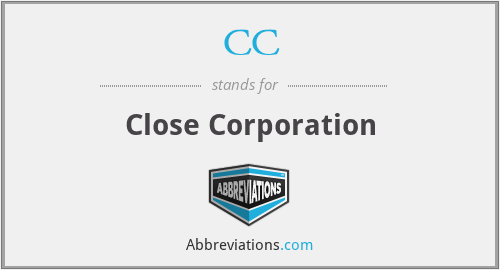Forms of Ownership- Close Corporations 25-06

FORMS OF OWNERSHIP
Also read the chapter on forms of ownership on the study guide on the D6, pages 88-98
Close Corporation (CC)
A Close Corporation CC is an optional association of one or more persons, not exceeding ten, who qualify for membership in terms of the Act 69 of 1984, and secure its incorporation by complying with the requirements of this Act.
Characteristics of Close Corporation
’Owned by members. 1-10)’
1. A Close Corporation is subject to Close Corporations Act 69 of 1984 and the Companies Act 71 of 2008. Under the new Act, close corporations are treated a lot more like companies
2. The name must end with the suffix CC.
3. A Memorandum of Incorporation is not required, but a founding statement (K1 no longer in use because there are no new registrations) signed by, or on behalf of, every prospective member used to be lodged with the Registrar. Amended founding statement CK2 is still in use.
4. A Close Corporation is a legal person so members are not liable in their personal capacity. It is a separate entity that exists separately from its members
5. Members of the CC both own and control the business
6. Usually two or more members have to sign legal documentation
7. Initial contributions are required to be made by members, but are usually nominal or it does not have to be equal to other contribution
8. Members do not have shares but ‘interests’ expressed as percentages, and they may not dispose of their interests without the consent of the other members.
9. Close corporation financial statements may be required to be audited unless exempted by law or independently reviewed by the accounting officer depending on its Public Interest Score at the end of the financial year.
10. All members of the CC may take part in management
11. A Close Corporation does not need an auditor but does need an accounting officer.
12. A Close Corporation is subjected to double taxation like companies, i.e. they are taxed on CC’s income and Standard Tax of Company (STC) on members’ dividends can be terminated in a Court of Law.
13. Close Corporation information is available to its members.
14. A CC has continuity. It is not influenced by the withdrawal of a member.
15. Members of the CC are paid according to the percentage interest owned by each.
16. The voting rights of the members should correspond with their respective member interest or ownership percentage.
Advantages of a Close Corporation (CC)
1. A Close Corporation is easy to establish and to operate because there are fewer legal requirements than companies.
2. A Close Corporation is not required to hold annual general meetings (AGM). Meetings are not compulsory and can be held on an ad hoc basis
3. A Close Corporation is regarded as a legal entity/person; this is an advantage because it means that the continuity of a CC is not linked to the status and life of the members. The life of the close corporation is perpetual.
4. Different members bring different skills (managerial and decision making skills) to CC.
5. A Close Corporation can be converted to a Private company and members may become shareholders.
6. Transfer of ownership is easy. It can be transferred to individual if all members agree.
7. You’re somewhat protected from other members. If there’s no association agreement in place, then all important decisions are made by majority vote. Each member has a vote equal to the percentage of the close corporation that they own.
8. There are no directors therefore, no complex rules like in companies where directors are subjected to more rules.
9. Close Corporation may be exempted by CIPC from auditing its financial statement.
10. There is limited liability.
Disadvantages of a Close Corporation
1. The number of members allowed in a Close Corporation (CC) is 10. This could limit and hamper the growth and expansion of the business.
2. A member of a CC can be personally held liable for the losses of a CC if the member acts carelessly or irresponsibly on behalf of the business, or without skill.
3. Banks or loan establishments might require the financial documents of the CC to be audited when a CC applies for a loan. Funds will not be released until the auditing has been completed.
4. All members must agree to dispose of a member’s interest. This could make it difficult for members to leave the CC or to pay a member their portion.
5. A CC pays company tax AND members also pay personal tax on salaries they receive.
6. It is not possible to sell a CC to a company because companies cannot be converted into CCs. First the CC needs to be converted into a private company, and this can take time.
7. A Close Corporation is subjected to double taxation like companies, i.e. they are taxed on CC’s income and Standard Tax on Company (STC) on members’ dividends. The company tax rates are significantly higher than personal tax rates that apply to partnerships and sole traders.
8. A Close Corporation is governed by CC Act 69 of 1984 and the Companies Act 71 of 2008. There are more legal requirements than sole proprietorship and partnership.
9. A Close Corporation may be expected to audit its financial statement unless exempted by law